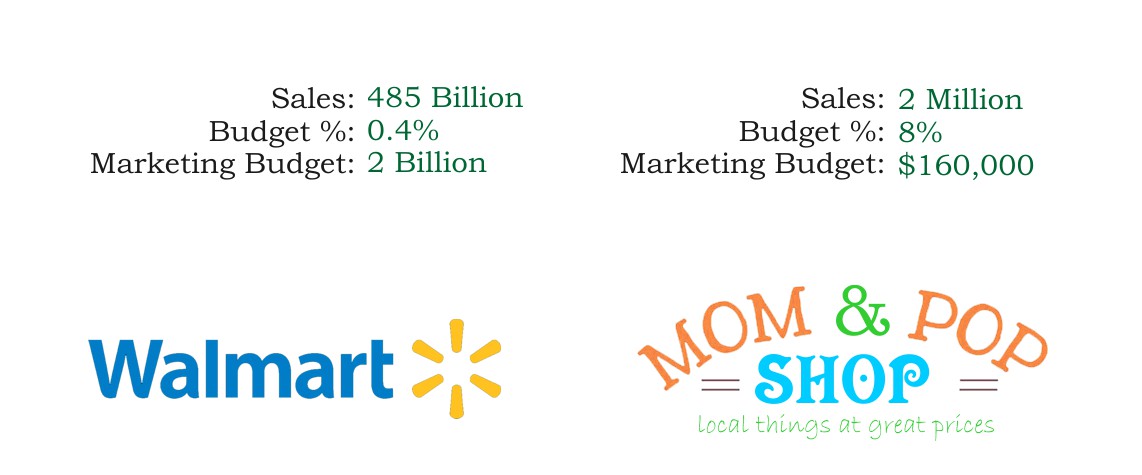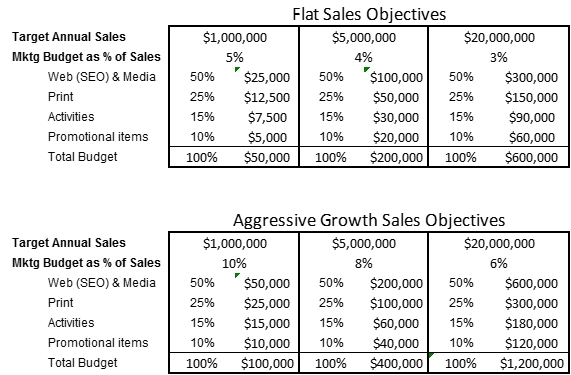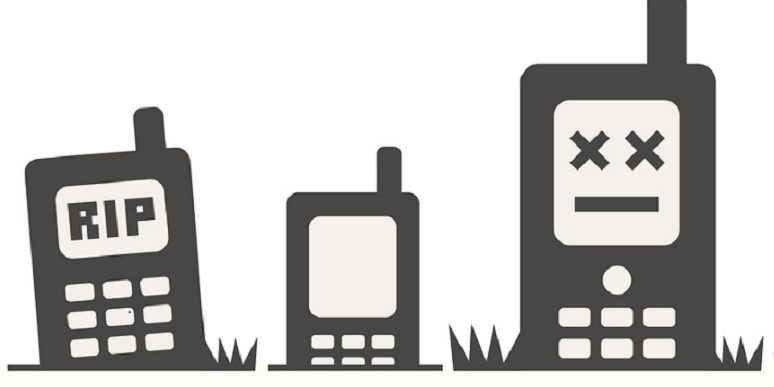
When having a discussion with clients about their marketing budget, we have discovered that most have a number in mind – and it is usually based on ‘gut feel’ than any logic. I recommend every time that they use a figure anchored by the effect or objectives they wish to achieve. I show them that there is a correlation with marketing spend and sales results, and the logic in this seems to make a lot of sense to all of us.
We have in the past seen a number of simple and complex formulas used and they all pretty well revolve around a standard five percent of sales as a starting place, but to apply any sense of accuracy we need to know more about what we want to achieve.
When we see someone spending less than 5% and not meeting their sales targets, we suspect they need to spend more. On the other hand, if they are spending over 10% and not meeting their targets, then we suspect they are over-spending or spending on ineffective ways.
We can use several factors to determining what percentage of sales to budget towards marketing for a particular business.
We have seen marketing budgets range anywhere from 1 percent and 30 percent of sales revenue. However, a recent study showed that of the organizations responding, 58 percent of businesses’ marketing budgets were under 4 percent of their sales revenue. Only 2 percent of businesses were spending above 20 percent.
It is safe to say, that SMB businesses should plan on spending at least between 5 percent and 10 percent of sales revenue on marketing, in order to execute an effective marketing plan with specific sales objectives and using the projected sales targets to calculate the marketing budget to achieve it. In other words, if you had sales of $4M last year with a sales target of $6M for this year, your budget should be 5% of the $6M rather than 5% of the $4M.
The volume of sales has a significant impact. Walmart, for example, only spends around 0.4 percent of their annual sales revenue on advertising, but because of their significantly high volume of sales this calculates out to a substantial advertising budget amount that can accomplish the same brand building and marketing ROI as another retailer's larger percentage. The higher the volume of sales a business does, the lower the percentage of sales they can expect to spend.

It costs more to market new products, new services and new geographies than it costs to market the existing. So if a business is launching a new product, service or geography (basically a new audience), the percentage of annual sales revenue they will need to budget for marketing will be a higher percentage than a company that is spending marketing dollars to continue to promote an established product line in an established market. As well, speed of growth and expansion will also determine how much needs to be spent on marketing and advertising. A rapid growth strategy will need a larger budget to achieve objectives in a shorter timeframe.
With approximately 50 percent of marketing funds going towards building brand awareness, companies that have established a strong brand in their given markets have a competitive edge when it comes to how much they will have to spend to maintain their brand awareness.
So we can say the brand awareness investment can reduce future marketing costs. On the other hand, if a company's target market is not familiar with either the company itself or the brand of products or services that company offers, the percentage of sales revenue budgeted for marketing will need to be higher and include a variety of media.

A typical marketing budget expressed in percentage of sales might look like this for achieving normal sales objectives and aggressive sales across a variety of target revenues.

So it becomes clear that growth consumes more marketing expenses but higher volumes require a lesser budget as expressed as a percentage of sales.

Cold calling is dead; long live digital marketing! This reality explains the high percentage of budget spent on digital and other media items. TV, Radio and Web media content is what drives sales today (or converts cold calls to warm calls), especially where brand investment is concerned. While smaller companies can rely on web media for this, as the company size, complexity and reach increases, other media become important in the brand recognition race amongst competitors. The addition of these other media channels accounts for the proportion of budget for ‘Web (SEO) & Media’ line item percentage to be maintained even across higher sales numbers.
While the understanding of typical marketing budgets explained here will help set expectations for organizations, we believe strongly that all marketing should be held to a promise of ROI and quarterly assessments used to make sure it happens. If a particular marketing activity is not contributing the number of qualified leads or help close the amount of business promised, it should be investigated. Has it been properly deployed and have we given it enough time to show results? Was the expectation reasonable and valid? What is the barrier to success and how can we remove it? Should we be doing something else to meet the marketing and sales objectives? Quarterly effectiveness reviews will protect this budget and better unsure meeting the objectives of your marketing plan.
Fundamentally, marketing costs are an investment in sales revenue; spending too little or on the wrong things will result in failure to meet revenue objectives. Using a logical approach to budgeting linked to the return will help create real achievable expectations.



1.844.493.1098